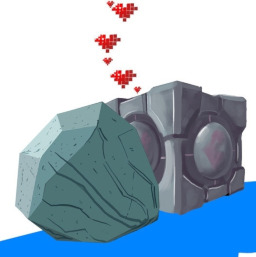
Interlude: Imagine a Pony's Brain
Imagine Twilight's brain as some giant Steampunk machine. Big iron walking beams slowly marching up and down, keeping steady time, driven by small engines with big flywheels.
Nearly every bit of their workings exposed to view—giant cast flywheels spinning around, screw-type governors on the machines, the constant hiss of steam.
And that’s just for the heavy lifting. Other processes are more fine-tuned, clever contraptions of gears and escapements, regulators and countwheels, racks and snails, everything in shiny brass with a thin sheen of lubricant on it.
Decorative trimwork, because why not? If you’re going to build a machine, make it a thing of beauty. Glossy green enamel, pinstripes painted with a feather, decorative scrollwork on every machine because it’s not just a thing, it’s an art, it’s a masterwork.
It needs a whole crew to run it, and to keep it running. While a governor keeps an engine from overspeeding, a careful hoof on the steam nozzles can finely set the shaft speed.
Bells ring out, the telegraph system, for it’s too loud to hear voices shouting when everything is operating. Wipers go everywhere, crawling over the moving machines with their little cans of oil, lever-operated with a bendy spout. A rag is always tucked in a back pocket, white at the beginning of a shift and stained brown at the end of it.
Dynamos spin off exhaust steam, and the lights dim when a heavy demand is made; voltage regulators haven’t been invented yet.
Everything working like clockwork, and then a pony goes and says something crazy and that’s like a broom handle jammed into a clock gear—everything comes to a grinding halt, safety valves pop and for a moment nothing can be heard over the shrill shriek of steam. The air is thick and heavy; everyone looking around for the malfunction. Control wheels spin, bells ring, steam nozzles are shut off, the electric lights flicker and dim as the dynamo spins its last, and then all is silent except the clang of a wrench on a catwalk.
The machine has malfunctioned, and the machine needs to work. Ponies scramble to action, engineers shout orders, the cause is identified. It can be fixed, but that will take a while, a new piece needs to be patched in and the machine cannot be left idle for too long.
A workaround is found. Not with shop drawings, not with a long study, it’s all back of the hoof calculations by grey-muzzles in their navy blue coveralls. Shut that valve, reduce steam pressure to the triple-expansion engine; orders are shouted and carried out without question. One of the main beams is stopped at full height; that’s a design flaw they all know. A hempen rope over the beam and a dozen ponies pulling in sync as the starter gear is engaged and it starts to sluggishly pull itself downwards, at first resisting the inevitable expansion of steam and then its momentum starts to take over. The beam weighs tons for a reason—it doesn’t start or stop quickly, but when it’s going, it’s going.
Essential processes are online. Emergency lanterns still provide the only light; the dynamos are still and silent.
Clockworks are cleared and reset, pendulums are set in motion again. A steady ticking as the duplex escapement starts moving again, followed by the whirring of the wheel train. Things are starting to work again, but it’s a demanding process getting everything back online especially as an unexpected command comes from on high; steam pressure’s not yet back up, half the machines are still in their startup process, and the crew does what they can with the pressures and machines they’ve got to work with—something is better than nothing, right?
“We’re giving her all she’s got, captain,” the third engineer shouted, hoof deep in a packing gland.
Hooves on valve wheels, more steam nozzles open, a low whirr as the first dynamo gets a breath of escaping steam. Filaments in the lamp are glow-worms, less than a candle, and then it gets a bite in and ramps up, ffffwwwweeeeeeeeeeeeeettttt. Not a success until the steady drip of condensate is established.
The heartbeat is almost back—trained ears can hear the absence of some machines, the off-rhythm pulsing of walking beams and oscillators, can hear a governor race up and spin out as the steam supply to that machine is too high; its partner isn’t online yet.
But they’re getting there. A disaster has been averted; everything is coming back online as quickly as well-trained experienced ponies can manage. For the grey-muzzles, it’s yet another malfunction, and later on while they’re on their union tea-breaks, they’ll reminisce about the failure during HRH 1001 or the Pink One Conflagration [everypony agreed that the Pink One Conflagration was the worst failure thus far, having been a long-running disaster in progress followed by a significant fire].
For a rookie, it’s her first trial by figurative fire, and after a few moments of panic—she’d just learned where the emergency lanterns were and then forgotten in the heat of the moment—she got right up into the maw of the machine like everypony else and did her duty.
Medals aren’t awarded to the crew, but they should be. Fitters and wipers and pumpmares all did their duties; the engineering crew averted disaster once again. Already at ninety percent capacity, and the crew was clearing the (metaphorical) broom handle out of the mechanism, checking the gears for stress fractures or missing teeth. It looked good, things would be back to normal soon—
💭🗯💭
In reality, brains are just electrically-charged tapioca, subtle and nuanced beyond the ken of science.
In the case of unicorns, there’s probably some rainbows and sparkles in there somewhere, too.


.
.
.
wat
11556239
It's how the pony brain works! (more or less)
What an amazing, hilarious, beautiful aside!
11774078
Thank you!